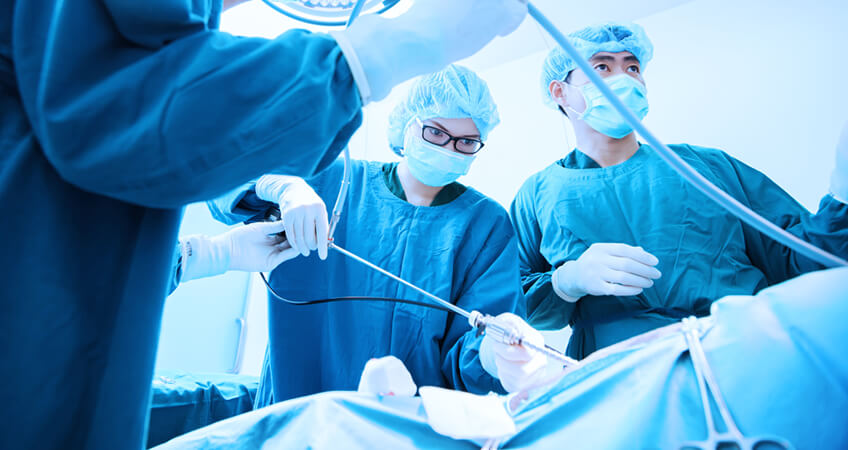Laparoscopic surgery is the most advanced technique to perform any aliments those which need surgery. In Tamilnadu, Laparoscopic treatment are being done in state of art.
The event of laparos- copic surgery began in the early years of 20th century. It has been the most significant advancement in general surgery in recent years. Over the last decade, laparoscopic surgery has gripped with firmness the international community as much as the laparos- copic technique.
What is Laparoscopy?
Laparoscopy is the method by which the abdominal organs are visualized on creating a pneumoperitoneum within the abdominal cavity. Via a camera attached to a rigid telescope. The image transferred by the telescope is visualised on TV moni- tor. The magnification seen on the TV monitor is twenty times bigger than normal. The clarity of vision is superb and absorbing. It can be performed under local and general anesthesia.
Indication :
Therapeutic procedures appendicec- tomy – Chelecystectomy – adhesion release procedure – primary varico- celectomy for made infertility– hernia repair – gynaecological procedure – assited hysterectomy – ovarian cyst aspiration – tubectomy.
Diagnostic laparoscopy:
Liver disease, Ascites of unknown origin, Staging of Malignancy, Chronic/ Acute abdominal pain, Fever of unknown origin, Trauma abdomen, Tuberculosis of abdominal organs.
Advance laparoscopic procedure:
Splenectomy, Gastric surgery–trun-kal vagotomy with gastro–jejunos-tomy–Posterior trunkal vagotomy with anterior seromyotomy, Colonic surgery–Hemicoloectomy, Assisted AP resection, Rectopexy for rectal prolapse, Thoracoscopic procedu-res–lung biopsy Oesophagectomy.
Lap Cholecystectomy:
Gall stone is common disorder man- aged by surgeons. The gall stones within the bladder are removed either by laparoscopic surgery or open cholecystectomy. If stones are present in bileduct, prior ERCP with sphinctertomy is necessary before cholecystectomy. Acute cholecystitis, chronic chole- cystectomy is performed. Acute gangrenous cholecystitis, Malig- nancy Cardio-respiratory problems and cholectoentertic fistula are contra – indication for surgery. Open chole-cystectomy, which was performed unchallenged over a century now faces almost an abrupt end due to laparoscopic surgery.
Laparoscopic cholecystectomy offers better cosmetic results negli-gible incidence of infection, incisio-nal hernia and nerve entrapment.
Laparoscopy Appendicitis:
Appendictis is one of the commonest disorder encountered by general sur- geons. Acute appendicitis, chronic appendicitis and any form of appen- dicular inflammation is an indication for surgery. Relative contraindication for sur- gery is appendicular mass and ab- cess, but, in an experienced hand it can be operated. During pregnancy, laparoscopic appendicetomy in con- traindicated. Today laparoscopic assisted hys- terectomy, Ovarian cystaspiration, oophrectomy and fallopian tubec- tomy, are being performed in primary male infertility and has increased over the last 5 years. The dilated (Varicocele) testicular veins is one of the causes for reduced sperm count in males. They can be operated upon with minimal scar, pain and 24 hours hospital stay.
Diagnostic laparoscopy is as much a surgical procedure as an explorative laparotomy. It is done as daycare procedure in most centres. There is no doubt regarding the diagnostic value of laparoscopy in gastro enterilogy and oncology. In some instan- ces, it avoids the need of laparatomy. It\'s indicated in liver disease, acute and abdomen, assists of unknown origin and staging of malignancy.
Liver Disease:
Laparoscopy is used extensively in hepatalogy. The macroscopic appea- rance of liver alone is highly diag- nostic, with biopsy confirmation de- sirable. The non-malignant disor-ders, which are of important disor-ders, which are of important to sur-geons are cirrhosis, hepatic cyst, liver haemangiomass and adenomas. In malignant condition, diagnostic laparoscopy has been widely used for staging of the malignancy and laparoscopy guided accurate liver biopsy, it avoids other more expen-sive investigative procedure.
Staging of Cancers:
Diagnostic laparoscopy can be used in pancreatic, Colorectal, Gastric and oesophageal cancer to stage the tumor. In these tumors, it is reliable method of identification of periton- eal, deposits, Diagnostic Laparos- copy is done to laparotomy to decide the operability of these tumors. In Hodg- kin\'s lumphoma stage III and IV can be graded by histological confirmation and typing, with multi-ple liver biopsy and splenic biopsy, can obviate the need for staging lapa-rotomy in up to 70% of patients.
Abdominal trauma:
The value of diagnostic laparoscopy in abdominal trauma has been vali- dated by prospective studies. It is indicated in stable case with stab wounds, blunt injuries buts contra indicated in these patients.
Contraindication :
Absolute :
1. Cardiorespitatomy sta- tus
2. Uncorrectable bleeding dis- orders
3. Abdominal wall sepsis
4. Unstable abdominal injuries
5. Chronic respiratory failure.
Relative :
1. Obesity
2. Tense ascites
3. Surgical condition like heatus her- nia, irreducible hernia
4. Intestinal obstruction.
In laparoscopic surgery there is 10 percent chance that it can be conver- ted to open procedure during surgery. It has a distinct advantage in various aspect compared to open procedure. Open exposure causes more trauma and increased catabolic response of the body. Post operative pain is largely caused by the parietal wound. It reduces mobility and respiration. Increased incidence of adhesion on laparotomy due to breach of delicate serosal lining. Open parietal wound is prone for infection, dihiesence and incisional hernia-Prolonged hospital stay.
Advantage :
1. Less pain
2. Less trauma
3. Less scar
4. Less hospital stay
5. Less cost
6. Comfortable postoperative stay
7. Early return to family life and work.


